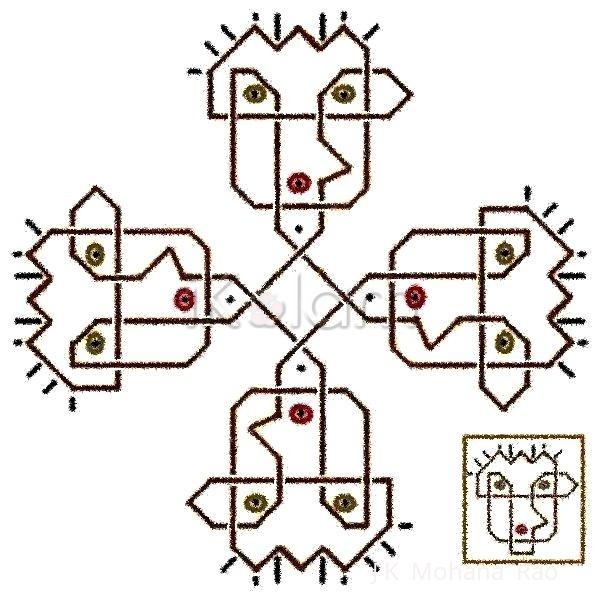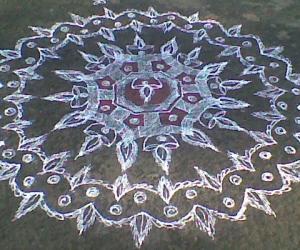Cartoons in knots :-)
About Cartoons in knots :-) : PRINT
Whenever one string or two strings meet, it is called a cross-over. For a given number of cross-overs, several knots are possible. For example, if the number of cross-overs is seven, there will be seven unique knots. As the number of cross-overs increases, the number of knots increases enormously. Normally, we take the string straight as you would have observed in many of my patterns. The string need not always be straight. I have made a cartoon-like figure with one of the seven cross-over patterns (inset). I joined four of these to get a bigger pattern. This has only one string. To an extent, Simpsons inspired me in this work. Enjoy!
Regards! - mOhana




Comments
smahalakshmi
Wed, 2011-04-20 10:56
Permalink
JKM sir, very beautiful design.
Mahalakshmi
Suguna Murugesan
Wed, 2011-04-20 11:11
Permalink
nice design!-suguna murugesan
ammuchandhini
Wed, 2011-04-20 19:26
Permalink
Aahaa...nice pattern jkm sir....and i am curious to know about ur new profile picture....what does it imply...i know J and K are the tenth and eleventh placed alphabets...but it seems u have reversed it...pl let me know...
julien
Wed, 2011-04-20 21:43
Permalink
Look like cartoon picture.... done a good work jkm sir.,
A.Julien
vasanthi
Wed, 2011-04-20 21:44
Permalink
very very nice pattern sir....aaaahhhaa good question rani mam. I'm also very curious about the same. Sir please explain.
Vinci
Wed, 2011-04-20 22:47
Permalink
WoW!!
alameluranganath
Wed, 2011-04-20 22:53
Permalink
nice pattern
Padma Prakash
Thu, 2011-04-21 01:11
Permalink
Good cartoon pattern. Even I am curious about the profile picture.
Jayashubha
Thu, 2011-04-21 04:24
Permalink
Very very nice simplified cartoon pattern. Its really looking very good.
P.Veni
Thu, 2011-04-21 07:58
Permalink
Lovely pattern.
jkmrao
Thu, 2011-04-21 09:52
Permalink
Thanks everybody! As for the M1001 puzzle, it is very simple, anybody who has some idea of the computer can solve the puzzle.
Regards! - mOhana
Anisha Raghunath
Thu, 2011-04-21 10:02
Permalink
very nice pattern.......
Vinci
Thu, 2011-04-21 16:49
Permalink
1101 looks like a binary number, its value is 13 and M is the 13rd letter, Am I close to the answer mOhanaji.
Vinci
Thu, 2011-04-21 16:50
Permalink
Sorry 13th letter.
jkmrao
Thu, 2011-04-21 16:53
Permalink
Yes, Vinci ma'am, congratulations!
Regards! - mOhana
Vinci
Thu, 2011-04-21 16:55
Permalink
Thanks mOhanaji, It was a warm up session for my precious organ
ammuchandhini
Thu, 2011-04-21 19:20
Permalink
Hey vinci....congrats....jkm sir believe me ...even i had a thought about binary numbers when u said related to computers... eventhough i taught integration,differentiation...even permutation and trigonometry to my daughter at her 9th std...i loved to hate this binary system ...donno why i was allergic to this...although my daughter said this is d most easiest amma...haha
jkmrao
Thu, 2011-04-21 19:41
Permalink
Do you know that binary system existed in India for nearly 2000 years, of all the places, in prosody?
Regards! - mOhana
ammuchandhini
Thu, 2011-04-21 19:43
Permalink
Yes jkm sir ...i have heard about this and also zero-0 was invented in India only ....am I right?
smahalakshmi
Fri, 2011-04-22 00:01
Permalink
Vinci, congrats that you solved the puzzle. But JKM sir please do explain the reason why you have put this 13th alphabet and 13th number in binary system in your profile picture. Does that have any relationsjip to your name or is it ur lucky number or is it ur birth date?
Mahalakshmi
Vinci
Fri, 2011-04-22 00:11
Permalink
Mahalakshmi, answer is in his comment
Thanks everybody! As for the M1001 puzzle, it is very simple, anybody who has some idea of the computer can solve the puzzle.
Regards! - mOhana
ushavenkatesh
Fri, 2011-04-22 04:15
Permalink
nice design sir.
rajamma_2
Fri, 2011-04-22 07:17
Permalink
Interesting work
rajamma
Dr.Rekha Shetty
Fri, 2011-04-22 21:00
Permalink
vinci,rajamma congrats!Rani,vinci still remember binary and trignometry?good then be ready for my next quiz...ah ah joking.Sir, fantastic work nice doggy face it reminded me of my valentine picture with my hero don't u ?
kameswari
Fri, 2011-04-22 21:34
Permalink
Nice design JKM Sir. The discussion on the profile is quite educative.
vasanthi
Fri, 2011-04-22 21:50
Permalink
WOW! great Vinci...you solved the puzzle. great idea JKM sir.
jkmrao
Fri, 2011-04-22 22:01
Permalink
In the system of prosody (the art and science of writing poetry) in Sanskrit and other derived languages except Tamil (they follow a different system of nEr and nirai), a long syllable which takes twice as much time to utter as a short syllable is called guru (heavy), and the short syllable a laghu (light). A line of poem consists of a group of these long and short syllables. Since any syllable has to be a guru or laghu, the line consists of binary numbers. The guru is given the value zero and laghu 1. Thus if we have a short-short-long-short syllabic structure, it is equivalent to 1101. The funny thing is ancient Indians wrote numbers in an opposite direction. That is, the least significant digit is at the left and the most significant digit is at the right. They also did multiplication from left to right. Thus the value of 1101 according to them is 11. For 13, it will be 1011. Not only this, they also knew how many arrangements with one zero and three ones are possible. This is nothing but our present binomial theorem (a in the binomial theorem is zero and b is one). These are all nearly about 1500 to 2000 years old. Thus each line in a poem with a certain arrangement of long and short syllables has a unique number associated with it. Thus if we know that number we know the syllabic arrangement. This is the origin of the binomial numbers in India. Its origin is in poetry and also music (in the tALa system).
Regards! - mOhana
Dr.Rekha Shetty
Fri, 2011-04-22 23:37
Permalink
Thanks for reminding the guru and laghu of the kannada grammer .Thanks for the brillient explanation ab;out our history of 0 and 1
vijaysowmya
Mon, 2011-04-25 00:36
Permalink
Very nice pattern. Thanks for your well explained information.